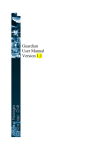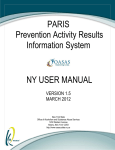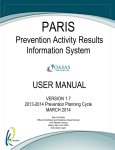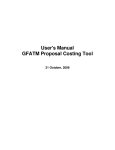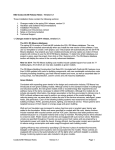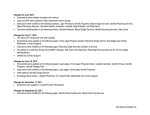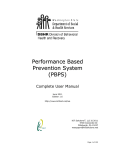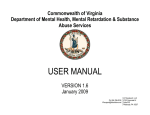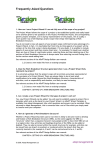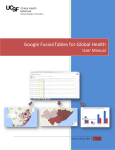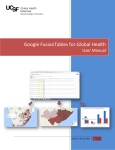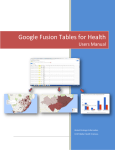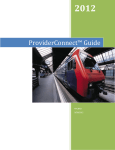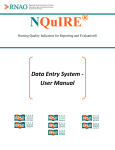Download FAQs
Transcript
PARIS FAQS
08-29-07
NYS OASAS
Prevention Activities and Results Information System (PARIS)
Frequently Asked Questions (FAQs)
(and Answers)
I.
Workplan Development .................................................................................- 1 PIN ..........................................................................................................................................- 1 Needs Assessment...................................................................................................................- 2 Target Population....................................................................................................................- 2 Service Approaches ................................................................................................................- 3 Performance Targets/Measurement ........................................................................................- 6 FTEs........................................................................................................................................- 7 -
II.
Data Collection ...........................................................................................- 8 -
Model & Non-Model Service Approaches .............................................................................- 8 Prevention Counseling............................................................................................................- 8 Feeder forms ...........................................................................................................................- 8 -
III.
Reports: Viewing, Printing, Saving............................................................- 8 -
IV.
Miscellaneous: System navigation, punctuation marks, revisions, etc. .....- 9 -
I. Workplan Development
PIN
Q: What is a PIN?
A: A Population In Need; a group identified by your Needs Assessment (NA).
Q: I provide the same non-model program in four school districts. Can I put them into one
PIN?
A: No, you need one PIN for each school district you serve. You can combine school
buildings within one school district into a group (see Custom Locations in the online User
Manual).
-1-
PARIS FAQS
08-29-07
Needs Assessment
Q: What if census data is used for archival indicator data? It only comes out every 10
years. What about the 3 year limit for archival indicators?
A: You can use school enrollment figures which are available or the census provides
periodic updates which will be within the 3 year time period.
Q: Are there any requirements for what defines an “acceptable” focus group?
A: No, but we will provide guidelines on the various needs assessment methods in the
PARIS Knowledge module, along with web links for training/TA resources.
Q: Does the county planning process “count” for archival data?
A: No. The OASAS County Local Services Planning Process is for results in an annual plan
for services and is not archival indicator data. If the county collects archival indictor data
(administrative data that has been collected from other service organizations) in their plan
to assess risk factors as a part of its needs assessment, then you could certainly use it for
your provider plan. However, if you have county level archival data (e.g., PRISMS) but you
serve sub-county populations (e.g., localities/school districts), you will have to collect needs
assessment data that matches your geographic service area(s).
Q: Will providers be held to a formal Needs Assessment immediately?
A: No. In the first year (2007) providers will be able to use the needs assessment data they
already have available, but they should make every effort to meet the new NA
requirements.
Q: Does (or will) OASAS require providers to conduct a specific Youth Survey?
A: OASAS has many competing priorities and a comprehensive needs assessment is an
important goal. Many states are now conducting statewide R+P youth surveys. We will
continue to address the barriers to community level youth R+P factor surveys and seek to
improve our capacity in this area. OASAS will not require youth surveys without the
resources and partners to make them feasible. In the meantime, OASAS has approved the
use of 5 community level youth R+P factor surveys that meet the requirements for PARIS
“population survey” (contact information is in the PARIS Library).
Target Population
Q: I know OASAS supports the Risk and Protective Factor Framework for
prevention. Will we now be a required to address a specific number of Risk and Protective
Factors in the Workplan?
-2-
PARIS FAQS
08-29-07
A: Yes, the minimum required will be: (2) Risk factors and (1) Protective factor Goals per
Workplan based on your needs assessment. These R&P factor Goals may be selected for
one Target Population, or assigned to multiple Target Populations.
Service Approaches
Entering Recurring Activities that start in 2007 but end in 2008:
Q: Some Recurring programs (Model and Non-Models) may begin in one year but carry
over into the next year. How do I enter these programs in the 2007 Workplan?
A: Recurring Programs often begin in one calendar year but will continue into the next
year (Start Date: Nov. 2007, End Date: Feb. 2008). Providers need to put Class/Groups
for these programs into the Workplan year they start. Please use the planned Start Dates
and End Dates for these ‘year crossing’ programs. Example: Life Skills Training
Class/Group starts Nov. 2007 and will end Feb. 2008. As the Class/Group begins in 2007,
put the planned Start and End Dates into your 2007 Workplan. PARIS will allow the End
Dates to be in the next year (e.g., 2008). During program delivery, enter your session data
in the Data Collection module using the Workplan that “owns” the Class/Group (in our
example the 2007 Workplan would be selected and both the 2007 and 2008 Life Skills
Training Class/Group session data would be entered there). The PARIS Reports module
will summarize the activity data separately for each calendar year.
Q: Some Prevention Counseling cases may be opened in 2006 but carry over into 2007.
How do I enter these cases in the 2007 Data collection module?
Workplan: Enter a PIN and Target Population for each School District or location where
Prevention Counseling participants are to be served.
Data Collection - Use the Prevention Counseling - Assessment screen to enter data for
participants admitted in 2006 and not discharged by December 31, 2006 ('open cases'
carried forward to 2007). You can use the actual 2006 Assessment and Disposition dates.
[For 2008 and the future, PARIS will automatically carry your open cases forward to the
next year (you will not need to do this again).
Q: Do I have to save after adding each Class/Group?
A: No, you do not have to save after adding each Class/group, but no data is saved until
you do click the Save button. You do have to save after all information is entered for that
screen. If you need to leave before finishing a screen, you should save before leaving.
Q: I have one group with 6 sessions and another has 8 under the same program. Do I have
to enter them as separate programs?
-3-
PARIS FAQS
08-29-07
A: No, you can register the groups under the same program, with 2 Class/Groups. If this is
a non-model program, specify the group sessions as an estimation (this is done once for the
entire program). You will enter the exact number of sessions in the Data Collection
Initiation for all recurring programs.
Q: If I change the session count, where is the proof showing that it has been changed?
A: The session count in the Workplan should be a projected number of what you plan to do
during the year. You will update this estimated session count later in the Data Collection
module: Recurring Program Initiation and Single Continuing Initiation screens. If the
session count is edited in the WP, the change will appear on the WP View report.
Q: I have a Non-Model program that has both 5 small group sessions and 8 classroom
educational sessions as components within it. How do I indicate which one is which?
A: Enter them as two different Non-Model programs. To know that they are both
associated with one program - give them the same 'Program Name' in the text box (e.g.,
Sarah's Stars - small group, and Sarah's Stars - classroom).
Q: Am I able to add a Class/Group during the year if I need to? Or do I need to request a
Workplan Revision to add it?
A: Additional Class/Groups may be added after the WP is approved. To add an additional
Class/Group, use the Add New button available in the Data Collection - Recurring
Initiation screen and provide the data requested.
Q: Is there a way to give the Class/Group a specific name?
A: You may edit the Class/Group name after adding it to PARIS. Click on the 'Edit' button
at the right side of each Class/Group entry.
Q: What is the definition and requirements for Prevention Counseling, one of the six
Service Approach categories in PARIS?
A: See existing OASAS Prevention Guidelines. PARIS has not changed any counseling
definitions or requirements.
Q: What is the definition of Shoulder Tap Surveillance (an Environmental Strategy)?
A: Minors are recruited to solicit adults to purchase alcohol for them and the number of
adults who do so is recorded. California uses this approach to gauge the success of its
social availability prevention efforts. In some cases, police arrest the adult purchasers and
the media report the results, thus discouraging others from buying alcohol for youth.
-4-
PARIS FAQS
08-29-07
Q: PARIS has two classifications of prevention programs: Model and Non-Model. What
about other “evidence-based programs” or programs that are classified as “evidencebased” or “effective” by other sources (e.g., Department of Education)?
A: At this time, only SAMHSA Model Programs will appear in the PARIS drop-down
menu. Anything not on that list will have to be classified as Non-Model, and entered
accordingly. After SAMHSA revises its classification of evidence-based programs and
practices (new NREPP system), PARIS will be updated accordingly.
Q: What about activities such as Red Ribbon Week’s poster contests? Are they classified
as Single Session Activities, or as an Environmental Strategy?
A: While events such as Red Ribbon Week are intended to increase awareness and focus
attention, they are not considered Environmental Strategies by themselves and would be
classified as Single Session Activities.
Q: Would Alcohol Awareness Programs (AAPs) be considered Single Session Activities or
recurring programs (Non-Model)?
A: If your AAP meets the following definition it is a recurring service:
• delivered to a fixed group of people for a minimum of four (4) or more sessions,
• over a fixed period of time in a planned sequence of activities,
• intended to educate, develop skills, change attitudes and behaviors.
If it doesn’t meet this definition, it would be classified as a Single Session Activity.
Q: If I am running a parenting group that meets weekly for 5 weeks with 10 parents and
we focus on several protective factors. Would this be classified as a recurring program
(Non-Model) or a Single Session Activity?
A: It would be a recurring program (Non-Model).
Q: Environmental Strategies that attempt to change policy may be multi-year…how will
PARIS measure this?
A: Your annual Workplan would describe your policy change initiative. PARIS monthly
data collection will capture the number of development meetings that take place with other
stakeholders that are working cooperatively, or in a coalition, to make those changes in
policy. The Performance measurement date in this case (the date the policy/law/regulation
is enacted) could be set for the following year's Workplan. The Service Approach would be
continued into the following year.
Q: What about prevention counseling for adults…Risk and Prevention factors don’t apply
to this population, right?
-5-
PARIS FAQS
08-29-07
A: Correct - Risk and Protective factor goals would not apply. Providers will write in the
other factors that demonstrate the need for prevention counseling in the Needs Assessment
section and select these as Other Goals for adult Target Populations. The provider will also
write in a performance target that is related to the Other Goals and write in the
measurement method they will use to measure the performance target. This is similar to
“verification” in the pre-PARIS Workplan.
Performance Targets/Measurement
Q: What is acceptable in terms of numbers of performance targets? OASAS feedback has
been inconsistent on this issue in the past.
A: Model Programs, Non-Model Programs, Prevention Counseling, and Environmental
Approaches require a minimum of one performance target each. Single Session Activities
and Single Session – Continuing do not require any performance targets.
Q: When will we have to measure participant outcomes in PARIS?
A: Not until 2008. The first year of implementation and training for 2007 activity
reporting will not include the Performance Measurement (outcomes) component.
Providers will be trained in the rest of the system first, while the outcomes module is pilot
tested with 20 volunteer providers. However, providers will continue to develop
performance targets for recurring services and continue with any local verification
methods they have been using.
Q: Where does fidelity fit into the Workplan versus reporting?
A: It does not fit into the Workplan. Model program fidelity will be measured as a part of
performance reporting. Providers will complete a Fidelity instrument on a sample of all
model programs after completion.
Q: If a program is working with a researcher to become a model program, will they
be required to use an OASAS instrument in addition to the researcher’s?
A: Yes, until it is classified as a Model Program, the program will be measured as a NonModel program. It will require the provider to identify risk factors or protective factors
and then select a measurement tool from the
OASAS performance measures menu.
Q: Where do providers find a “source” for pre/post outcome measurement tools?
A: All the outcome measures listed can be found on the CSAP’s Core Measures Initiative
website http://www.activeguidellc.com/cmi/index.htm
-6-
PARIS FAQS
08-29-07
Q: Pre and Post test outcome data is costly to achieve. Why doesn’t OASAS just get to
the core—provide evaluation tools that measure the Risk and Protective
factors that
are a priority?
A: We will select a "core set" of priorities after a pilot test in 2007. However, in the
OASAS Prevention Framework, priorities are determined based on local needs and
resource assessments; what is the core for one community will not be the core for another.
So local decision-making needs to be supported. NYS CTC Youth Survey results and
national data from the PRIDE survey have shown that communities with very similar
demographics within one county had significantly different risk and protective(R&P)
factors profiles and substance use rates. In addition, while the current research evidence
has identified 20 risk and 11 protective factors that are predictive of substance use and
abuse, the research cannot yet tell us which of these factors are the "core set". Finally, a
local resource assessment is needed to determine if anyone is already addressing the R&P
factors or has the capacity to do so as part of a community plan. A community partnership
may be the best vehicle to help set R&P factor priorities and develop a plan for who will
address them.
FTEs
Q: What does Total Direct Service FTE's mean? Is it staffing?
A: Yes, it is staffing. This is an estimate of Full-Time-Equivalent (FTE) staffing that can be
allocated to the preparation for and delivery of services for the major categories of
Prevention Service Approaches: Model, Non-Model, Prevention Counseling,
Environmental Strategies, Single Session Activities, and Single Session – Continuing. It
includes service related travel, materials production, and other preparation tasks
associated with the service. Direct Service FTE does not include provider planning, staff
supervision, general program development, resource development, marketing or other
general administrative activities.
Q: Is the direct service FTE for OASAS funding only, or for all revenue in my OASAS
budget? My OASAS Workplan includes 'Other Revenue' (non-OASAS)?
A: Because your OASAS budget includes both OASAS and other revenue sources of
funding, your direct service FTE should include all funding in your OASAS budget. The
PARIS manual includes a full definition of Direct Service FTE.
Q: Should non-paid staff (volunteers) be included in FTEs? This is a slight concern because
one of our contracted programs makes extensive use of volunteers who are integral to the
program design and deliverables. To not include them in the FTE count significantly
misrepresents the staffing resources that are necessary to produce the number served and
the performance targets.
A: No, enter only the paid staff in FTE. PARIS analyses and reporting will allow us to
identify Providers who make extensive use of volunteers and other in-kind resources and
-7-
PARIS FAQS
08-29-07
thus report greater service outputs than their funded FTE would indicate. Other providers
may be able to emulate their operations.
II. Data Collection
Model & Non-Model Service Approaches
Q: Can you collect and report data in the 2007 WP for recurring programs that began in
2006?
A: No. Only activities that take place in 2007 will be collected in the 2007 Workplan and in
2007 data collection.
Q: How do you code a Class/Group session that was cancelled because school had a snow
day and you can't do the session later on?
A: In the Data Collection module, Recurring Program(s) - Delivery screen, enter a zero ('0")
under Participant Number for that session and in the comment field explain that the
session was cancelled and why.
Prevention Counseling
Q: The monthly data entered for prevention counseling is an aggregate count. Does this
mean that we are entering gross numbers and that individual session attendance is not
recorded?
A: Yes, each month you only enter totals for the number of Individual, Group and Family
sessions delivered that month. The number of sessions each individual participant attended
during counseling is reported only at discharge.
Feeder forms
Q: Will programs be able to print individual pages for data entry feeder forms?
A: Yes, all PARIS screens are printable for use as feeder forms. There is also an optional
set of feeder forms provided in the Knowledge-base: PARIS Library module as of January
5, 2007.
III.
Reports: Viewing, Printing, Saving
Q: How can I view my Workplan before submitting it?
A: The WP can be viewed at any time by going to Workplan Approval in the main menu
and then selecting the View Workplan button. If unable to view, you may need to turn off
-8-
PARIS FAQS
08-29-07
a pop-up blocker on your browser. See 'Tips for Using the Application Effectively Recommended Computer Settings' in the online USER Manual.
Q: How can I save a copy of my Workplan before submitting it?
A: The WP can be saved to a file by selecting the Workplan Development Report in the
button, you will then see a print preview
Reports module. First click the
screen. To save the report, select either the PDF button or the Excel
button and follow the directions (see USER manual - 'Printing and Saving
Reports').
Q: It appears that providers will enter monthly reports and OASAS will give them a
quarterly report and an annual report thereby eliminating the need for the providers to do
so - is this correct?
A: Yes. Providers enter monthly data. OASAS, LGU and Providers will then be able to
access and print quarterly and annual standard performance reports. PARIS will also
have ad-hoc query capability, so reports can be generated for any time frame selected, i.e.,
quarterly, budget calendar year, school calendar year, etc.
Q: Will the current paper Service Activity Reports (PR forms) that we send to OASAS
Regional Offices still be required?
A: No, all activity reporting forms to OASAS Regional Offices will be replaced by PARIS.
Q: Will I be able to print out (monthly) data once I’ve entered it, without requesting a
report?
A: Yes, you can print one screen of data at a time, but data reports are also available in the
Report module.
IV.
Miscellaneous: System navigation, punctuation marks, revisions, etc.
Q: How do I get back to the PIN Inventory screen from the Service Approach screen? (or
back to any screen)
A: Using the “bread crumb trail” up near the top of the PARIS screen and just below the
main yellow menu bar, click on PIN Inventory, or click on Workplan Development in the
main menu.
Q: What’s the difference between the cancel and the delete buttons?
A: The cancel button will take you out of the page without changing or saving any of the
information whereas the delete button removes an existing entry completely from the
system (database).
-9-
PARIS FAQS
08-29-07
Q: The User Manual says not to use commas (',') in the numeric fields. What will happen if
I do? What about using dashes (-), apostrophes('), or other punctuation in the Staff - User
Name fields (ADMIN-Staff screen)?
A: If you enter commas, or any other form of punctuation in the numeric fields (other than
a decimal point in the FTE section), you will receive a “Run Time Error” when you try to
save your information. You will then have to close out and log back into PARIS, and you
will have lost any data that you entered on that screen. The same applies to dashes and
apostrophes in names, but in this case, you will find yourself unable to log back in using
that name, because the system won’t recognize the punctuation in names. Spaces between
last names are allowed. (e.g., Van Dyke)
Q: I need to make changes to my Workplan but I am unable to open it.
A: Check the Workplan status on the Workplan Approval screen. If you have submitted it
to the county or OASAS Regional Office it will be locked. You will have to submit a
revision request to the county for this Workplan by clicking the 'revise' button on the
Workplan Approval screen.
Q: What is PARIS?
A: The Prevention Activity and Results Information System (PARIS) is a “state of
art” web-based reporting system, used to collect data and report on OASAS funded
prevention services and their outcomes.
the
The PARIS system will support four major functions: annual planning using the OASAS
Workplan; monthly data collection on Prevention Activities; performance measurement
(outcomes); and production of reports at Provider, County, Regional and State levels.
Prevention providers will be able to create ad-hoc reports that will be able to identify the
activities they have conducted for any time frame they specify.
Q: How long will it take me to enter my new Workplan into this system? (I had four
different Service Approaches in last year's Workplan.)
A: We anticipate that the first Workplan entered into PARIS will have a learning curve
and will take more time than the previous paper Workplans. Existing and new OASAS
responsibilities for describing and monitoring of funded services, coupled with new goals
for practice improvement in the areas of needs assessment, planning and outcome
attainment have required a more detailed Workplan. Also, the PARIS Workplan
automatically sets-up and formats data collection screens to streamline provider data
collection and reporting. Subsequent years Workplan development will be faster as the
system will allow "carry forward" of most recurring content into your next year's
Workplan (e.g., 2008). The system also includes extensive "help" functions and a
knowledge-base to support continuous learning.
- 10 -










